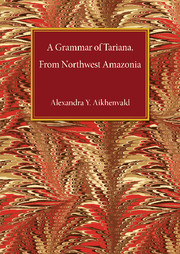Book contents
- Frontmatter
- Dedication
- Contents
- List of tables, schemes and diagrams
- Preface
- Acknowledgements
- Organisation and cross-referencing
- List of abbreviations
- Map
- 1 The language and its speakers
- 2 Phonology
- 3 Word classes
- 4 Nominal morphology and noun structure
- 5 Noun classes and classifiers
- 6 Possession
- 7 Case marking and grammatical relations
- 8 Number
- 9 Further nominal categories
- 10 Derivation and compounding
- 11 Closed word classes
- 12 Verb classes and predicate structure
- 13 Valency changing and argument rearranging mechanisms
- 14 Tense and evidentiality
- 15 Aspect, Aktionsart and degree
- 16 Mood and modality
- 17 Negation
- 18 Serial verb constructions and verb compounding
- 19 Complex predicates
- 20 Participles and nominalisations
- 21 Clause types and other syntactic issues
- 22 Subordinate clauses and clause linking
- 23 Relative clauses
- 24 Complement clauses
- 25 Discourse organisation
- 26 Issues in etymology and semantics
- Appendix. The main features of the Tariana dialects
- Texts
- Vocabulary
- References
- Index of authors, languages and subjects
26 - Issues in etymology and semantics
Published online by Cambridge University Press: 05 August 2013
- Frontmatter
- Dedication
- Contents
- List of tables, schemes and diagrams
- Preface
- Acknowledgements
- Organisation and cross-referencing
- List of abbreviations
- Map
- 1 The language and its speakers
- 2 Phonology
- 3 Word classes
- 4 Nominal morphology and noun structure
- 5 Noun classes and classifiers
- 6 Possession
- 7 Case marking and grammatical relations
- 8 Number
- 9 Further nominal categories
- 10 Derivation and compounding
- 11 Closed word classes
- 12 Verb classes and predicate structure
- 13 Valency changing and argument rearranging mechanisms
- 14 Tense and evidentiality
- 15 Aspect, Aktionsart and degree
- 16 Mood and modality
- 17 Negation
- 18 Serial verb constructions and verb compounding
- 19 Complex predicates
- 20 Participles and nominalisations
- 21 Clause types and other syntactic issues
- 22 Subordinate clauses and clause linking
- 23 Relative clauses
- 24 Complement clauses
- 25 Discourse organisation
- 26 Issues in etymology and semantics
- Appendix. The main features of the Tariana dialects
- Texts
- Vocabulary
- References
- Index of authors, languages and subjects
Summary
In this chapter, I first discuss the organisation of the Tariana grammar and lexicon from an etymological viewpoint (§26.1). Then, in §26.2, I consider a number of semantic issues which are relevant to the organisation of grammar. The last section, §26.3, discusses some issues in the lexical semantics of Tariana.
Tariana grammar and lexicon: an etymological perspective
Arawak grammar and lexicon in Tariana
Like many other Arawak languages, Tariana preserves the following categories (Aikhenvald 1999b):
•cross-referencing (Chapter 6) and pronominal genders (Chapter 5);
•the number markers -ne, for humans and animates (from Proto-Arawak *-na/-ni), and -pe, for nouns of other groups (from Proto-Arawak *-pe) (see Chapter 8); and
•the common Arawak markers of attribution ka- and negation ma-.
There are just a few traces of possessive markers: -si ‘marker of non-possessed nouns’ (from Proto-Arawak *-tʃi); and the markers of possessed forms of alienably possessed nouns' -ni (from *-ne/-ni), -ɾe (from *-ɾe) and -na (from *-na) (see §6.4). Tariana preserves a common Arawak irregularity in the alternation between the unpossessed and possessed forms of the reflex of the Proto-Arawak pana/pani ‘house’ (see §6.4.4). (For an outline of Proto-Arawak grammar and lexicon see Aikhenvald forthcoming-d and 1999a, and Payne 1991.) Cognates in other grammatical categories – such as valency changing derivations, classifiers, case-markers and markers for other verbal categories -are problematic.
Most terms for body parts have cognates in other Arawak languages and can be reconstructed for Proto-Arawak (see Payne 1991), e.g.
- Type
- Chapter
- Information
- A Grammar of Tariana, from Northwest Amazonia , pp. 594 - 619Publisher: Cambridge University PressPrint publication year: 2003



